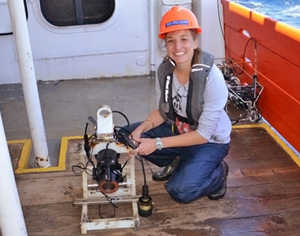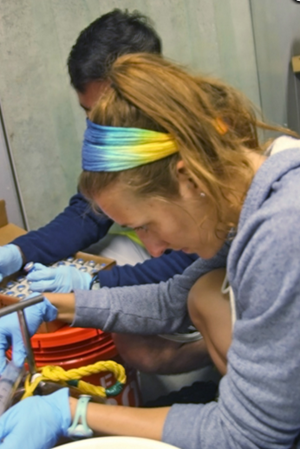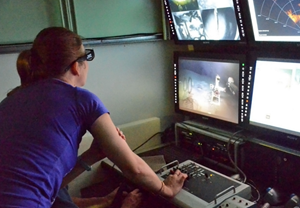
Caroline Johansen displays one of her camera systems that was lost for 9 months and found after three days of searching the seafloor. (Photo provided by Johansen and taken by a crew member of the R/V Pelican)
Caroline Johansen laughs when her family tells others that her research involves counting bubbles. But the bubbles she studies come from seeps at the bottom of the Gulf and contain naturally-occurring hydrocarbons that are an important part of the deep-sea ecosystem.
Caroline wants to shed light on how much oil enters the water every day through seafloor seeps in the Gulf of Mexico. Entire communities of deep-water bacteria as well as other organisms rely on these seeps for their survival.
Understanding the role of naturally-released hydrocarbons as part of a healthy marine environment can help scientists better gauge the impact of large hydrocarbon inputs such as from an oil spill. Caroline explained, “It is important for people to understand that the presence of oil in the ocean is not always a bad thing. It depends on the location, quantities, and time scales over which the oil enters the ocean. Understanding the amount released and the mechanisms involved can help us formulate a better understanding of the ecosystem.”
A Ph.D. oceanography student at Florida State University (FSU), Caroline is a GoMRI scholar working with ECOGIG. She talks about her research process and what she hopes to achieve.
Her Path

Caroline extracts gas from a “funnel beaker collector” that she designed and built to collect gas from natural seeps. (Photo credit: Ian MacDonald on the R/V Atlantis)
“I always asked a lot of questions and looked at the world with wonder,” Caroline said, explaining how she first became interested in oceanography. She grew up all over the world—living in seven different countries on four continents. Because her father worked in shipping, she realized at an early age that the ocean connected the planet like nothing else.
Caroline originally wanted to be a veterinarian, but a job at an animal clinic convinced her otherwise. After she completed her undergraduate degree in animal biology at the University of Florida, she took a short-term volunteer position as a research assistant for Katja Petersen Ph.D., affiliated with the University of Pretoria in South Africa. Working off the coast of Ganbaai, Caroline tracked the path of Southern Right Whales. She adored the open ocean field work and decided then to pursue a career in marine research.
While exploring graduate programs, Caroline discovered FSU’s Ian MacDonald’s work on oil seeps with the ECOGIG consortium. The concept of oil leaking into a marine environment as part of a natural process was completely new to her. She entered a master’s program in January 2012. Shortly afterwards with Dr. MacDonald’s encouragement, who was impressed by the quality of her research, Caroline moved into a doctoral program.
Her Work

Caroline works with the ROV operator to position the camera in front of a hydrocarbon vent. (Photo credit: Dante DelGrosso, Oceaneering)
Caroline has developed new image processing methods to quantify the amount of oil coming through seeps. “I use underwater video cameras to look at natural seep sites. Then I process the video data to determine how much and how fast oil is naturally being released into the water column,” she explained. In other words, Caroline counts bubbles coming up from the seafloor.
This counting process is not as simple as she makes it sound. First, Caroline uses MacDonald’s satellite imagery of the Gulf to identify sites where oil may be seeping. Then she goes to the site on a research vessel equipped with a specially-modified video time-lapse camera (VTLC) mounted on a remotely operated vehicle (ROV). Caroline works with the ROV operator to carefully and accurately position the camera hundreds of feet below the water’s surface so she can video the oil rising. The length of time the camera deploys has varied in her seven trips—as short as three hours and as long as one month. Caroline must calculate the camera’s memory capacity in advance to know how often she can film during longer deployments—sometimes only seconds an hour.
Caroline processes the video data in the FSU lab. First, she isolates individual still frames from the streaming imagery. Then she uses a program to calculate an average size and distribution of the bubbles in each image. She measures and contours each bubble by hand, a process which can take more than a week. Finally, a computer program counts the bubbles by creating a line in the image and numbering each bubble as it crosses.
Caroline said that finding the location from which oil and gas come from and learning how it travels through the sediments can help us understand the complex dynamics of deep-sea seep systems. She wants to improve overall understanding about Gulf processes when they are working as intended, so that scientists will have a baseline if there is another large spill.
Her Learning
Caroline feels the biggest challenges—and, therefore, the biggest opportunities for learning—lies in fieldwork. She explained that conditions at sea can be challenging, but when she and her team accomplish their tasks, it feels like a victory. Field work with researchers in close proximity can spark great ideas, but circumstances have also forced her to solve problems on her own. “Sometimes you are faced with stressful or challenging situations, and you need to come up with a solution,” she explained. “You learn a lot about yourself.” Long hours of lab analysis follow the shipboard excitement. This exercise in patience provides its own reward in the form of usable data.
Caroline’s biggest pleasure comes from sharing what she has learned, particularly during education and outreach activities. She said that working with ECOGIG has taught her to communicate and work with various types of personalities. Being a member of the ECOGIG team and attending GoMRI meetings with like-minded learners makes her feel like she is participating in something larger than her focused work. She explained, “Unlike other events, the GOMRI conferences have a sense of familiarity and community.”
Her Future
Caroline hopes to finish her Ph.D. by the spring of 2016. She is considering a range of options from continuing in academia to entering industry. Regardless of which path she takes, she feels that communicating science to the general public is of the utmost importance. Helping people understand how seemingly small scientific findings, like those that come from counting bubbles, relate to a bigger-picture understanding of Gulf ecosystem health is one way to accomplish that.
“I am open to applying the skills I have gained to a wide range of positions involved with the deep sea. Regardless of where I continue my career, I would like to stay involved in both education and outreach,” she said.
Praise for Caroline
Ian MacDonald said of “Caro,” the nickname her friends and shipmates have given her, “What I really appreciate about Caro is her cheerful ability of rising to challenges. It doesn’t matter if she is handling heavy gear in rough seas, teaching a 6th grade class, addressing an audience of seasoned scientists, or learning a new programming language, she goes all-in and does it with a smile.”
MacDonald explained that her observations link to the larger picture of hydrocarbon migration, saying, “Her video clips reveal a beautiful and startling ‘microscape’ of oil, gas and gas hydrate, and an enormous numbers of ice worms.”
Calling her research “original and transformative,” ECOGIG science lead Samantha Joye said that Caroline is an ideal representative for the GoMRI Scholars Program. “Caro is a bright, talented, and hard-working young scientist,” said Joye. “She is exceptionally willing to support the efforts of others, whether through intellectual input or staying up half the night to help someone get their samples processed.” She added, “I could not be more proud to include her as part of the ECOGIG team.”
The GoMRI community embraces bright and dedicated students like Caroline Johansen and their important contributions. The GoMRI Scholars Program recognizes graduate students whose work focuses on GoMRI-funded projects and builds community for the next generation of ocean science professionals.
Visit the ECOGIG website to learn more about their work.
************
This research was made possible in part by a grant from BP/The Gulf of Mexico Research Initiative (GoMRI) to theEcosystem Impacts of Oil and Gas Inputs to the Gulf (ECOGIG) consortium.
The GoMRI is a 10-year independent research program established to study the effect, and the potential associated impact, of hydrocarbon releases on the environment and public health, as well as to develop improved spill mitigation, oil detection, characterization and remediation technologies. An independent and academic 20-member Research Board makes the funding and research direction decisions to ensure the intellectual quality, effectiveness and academic independence of the GoMRI research. All research data, findings and publications will be made publicly available. The program was established through a $500 million financial commitment from BP. For more information, visit http://gulfresearchinitiative.org/.
